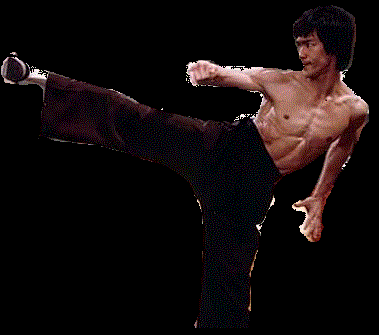The butterfly sword (simplified Chinese: 蝴蝶双刀; traditional Chinese: 蝴蝶雙刀; pinyin: húdié shuāng dāo) is a short dāo, or single-edged blade, originally from the South of China, though it has seen use in the North.
The blade of a butterfly sword is roughly as long as a human forearm, which allows for easy concealment inside loose sleeves or boots, and allows greater maneuverability when spinning and rotating during close-quarters fighting. Butterfly swords are usually wielded in pairs. A pair of swords will often be carried side by side within the same scabbard, so as to give the appearance of a single weapon.
The butterfly sword has a small crossguard to protect the hands of the wielder, similar to that of a sai, which can also be used to block or hook an opponent's weapon. In some versions the crossguard is enlarged offering a second handhold, held in this position the swords can be manipulated in a manner akin to a pair of tonfa. They may also be used as brass knuckles when non-lethal application of the weapon is desired.
Traditionally, the blade of a butterfly sword is only sharpened along half of its edge - from the middle of the blade to the tip; this can be seen in all vintage specimens from the Qing Dynasty. The blade from the midpoint down is left blunt so that it can be used to deliver non-lethal strikes and to block without damaging the sharpened edge. Butterflies were generally commissioned for individual martial artists, not mass produced, so every set of swords is different, however an average blade today is about 11½" long with a 6" handle.
Butterfly sword


Usage:
Butterfly swords are used in several Chinese martial arts, notably Wing Chun, Shaolin, Lau Gar and Hung Gar. In Wing Chun, one notable aspect of butterfly sword combat is that its principles are the basis for all other weaponry. In theory, any object that can be held in the hands of a Wing Chun practitioner will follow the same basic principles of movement as the butterfly swords. This is because the use of butterfly swords is simply an extension of empty-handed combat.
The design of the weapon, including the quillon (crossguard) shape, blade profile and blade length, are specific to each style of martial arts, the precise lineage, and individual. For example, some martial arts lineages flip the butterfly swords between the forward and reverse grip like a Sai, and consequently need a quillon that will fit the hand during a reverse grip. Some lineages trap the opponent's staff or blade between the quillon and spine, and they need a longer quillon closer and more parallel to the spine than would fit a hand after flipping. Some schools like a hybrid quillon design that is adequate for both flipping and trapping, but optimal for neither.
Modern Stabber Blade Style Butterfly Swords:
Chinese War Era butterfly swords had a long narrow blade that emphasized stabbing. While a deadly stabbing blade with a sharpened swage—known as "Red Boat" knives—was used by Chinese revolutionaries in the Wing Chun lineage, modern Wing Chun practitioners tend to prefer a blade profile with a wider belly that emphasizes chopping and slashing. Wing Chun lore attributes this to the desire of Monks to maim rather than kill. These knives generally have a quarter circle style tip suitable only for chopping/slashing and not stabbing, or a shallower curve to a more pointy tip that will accommodate both.
The appropriate length of the blade is a combination of the lineage and individual. For a Hung Gar stylist, the length should be a few inches past the elbow when the knife is held in a reverse grip. Wing Chun schools that use techniques which twirl the knives inside the arm need a reverse grip blade length based on the distance to the interior of the bicep. Other Wing Chun schools measure to the outside of the bicep.
Butterfly swords are regarded by many Chinese martial artists to hold the most versatility and balance of offensive and defensive capabilities of any Chinese weapon, with many more capabilities than just a weapon.



